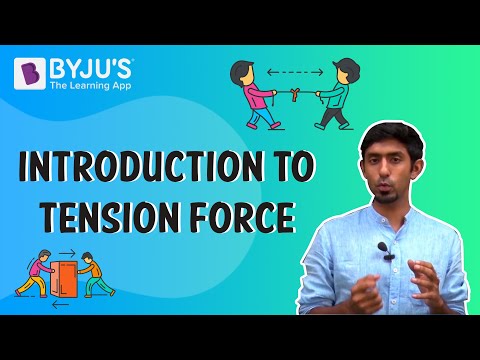As we know, every physical body exerts some force on one another which is in contact. Based on the kind of objects, these contact forces are assigned with names. If rope, cable or string is one of the forces exerting objects, we can call it tension.
What is Tension?
The force that is conveyed through a rope, string or wire, when pulled by opposite forces at each end, is known as tension force acting from opposite sides. Therefore, the tension can also be defined as an action-reaction couple of forces acting on the ends of a cable or string. The tension force pulls energy equally on the bodies at the ends, and it is directed over the length of the string.
Not only the endpoints but also the tension force is experienced by every segment of the rope in both directions. The tension force can vary in some circumstances throughout the string.
Since the cables and ropes can transfer a force over a specific distance efficiently, they can be used for exerting forces. Please note that since ropes cannot push effectively, the tension force will be the pulling force.
A massless rope transfers the force from one end to another perfectly.
Tension Force Formula
Numerically the tension on a body can be expressed as:
T = mg + ma
Where;
Tension is denoted by T in (N)
Mass of the object (m) in kg
Gravitational force (g) is 9.8 m/s2
Acceleration (a) in m/s2
Important Questions on Tension Force
1) If a motionless block of mass 10kg is kept on an inclined plane that has a force of tension 25N and the force of static friction is 40N, what will be the angle A, that is, the angle between the ground and the plane g=10m/s2 ?
a) 40.5
b) 26.2
c) 30.4
Correct Option: (a)
Explanation:
Friction, tension, and gravity are the three appropriate forces acting on the block in this case, where two of these values are given to us; therefore, we simply need to write an expression for the force of gravity in the direction of the slope.
Since the block is motionless, we can write:
Fnet=0
Fg−T−Ff = 0
Fg = T+Ff
Substituting the value of Fg in the horizontal component equation, that is,
Fg = mg sin(θ) we get,
mgsin(θ)=T+Ff
Therefore, to get the value of (θ)
θ=sin−1(T+Ff)/mg
Since, T = 25N, Ff = 40N, m = 10kg and g = 10m/s2
d) 38.4
θ=sin−1(25+40)/ (10)(10) =sin−1(0.65)
θ=40.5∘
2) On a smooth horizontal table, a particle of mass m is connected to a string of length l at one end, and its other end is to a small peg. What will be the net force acting on the particle, if it is moving in a circle with velocity v?
When a particle is connected to a string, and it revolves in a circular path around the centre, it requires a centripetal force to move in a circular path. In this case, the tension produced in the string provides the centripetal force. Hence, the tension T will be the net force on the particle, that is, F = T = mv2/l, where m = mass of the particle, F = net force on the particle, T = tension force.
3) A box of mass 2000 kg is lifted by a helicopter with a rope, and both helicopter and box are accelerating upward at 1m/s2. Calculate the tension in the rope.
a) 15.6kN
b) 21.6kN
c) 25.5kN
d) 12.1kN
Correct Option: (b)
Explanation:
Ftotal=F1+F2+…
ma=Frope+Fgravity
ma=T+mg
Plug in values:
2000∗1=T+2000∗ (−9.8)
Solving for T
T=21.6kN
4) A 20 kg block is hanging from a string, and an upward force of 4N is applied to the block. Calculate the force of tension in the string. Take g=10m/s2.
a) 196N
b) 130N
c) 70N
d) 103N
Correct Option: (a)
Explanation: The block has three forces on it: the force of tension, the force of gravity, and the upward pull force. Since the force of gravity is:
Fgrav = mg
Fgrav = 20kg∗10m/s2=200N
The upward pull plus the force of tension has to equal gravity; therefore, the block is in equilibrium.
Fgrav = FUpwards+FT
200N=4N+FT
FT = 196N
5) A block of mass 4 kg is accelerating at a rate of 4m/s2, the angle measures 30, and the coefficient of kinetic friction is 0.55. What will be the tension T? Take g=10m/s2.
a) 12.7N
b) 26.6N
c) 0.059N
d) 1.10N
Correct Option: (c)
Explanation: In this situation, friction, gravity and tension are the three relevant forces acting on the block. Hence, to express the system, we can use Newton’s second law:
Fnet=ma
Fg−Ff−T=ma
Substituting the values in the resolved components for the forces, we get:
mgsin(θ)−μkmgcos(θ)−T=ma
Rearranging the equations after cancelling out mass, we get:
T=[gsin(θ)−μkgcos(θ)]/a
T= [(10) sin (30∘) −(0.55) (10) cos (30∘)]/4
T=0.059N
6) If the block has a mass of 10kg and the angle measures 30∘, calculate the minimum value of the coefficient of static friction that will result in 0N tension. Take g=10m/s2.
a) 0.57
b) 0.40
c) 0.36
d) 0.12
Correct Option: (a)
Explanation: There are only two relevant forces, that is, friction and gravity will be acting on the block since there is no tension. Since the block is motionless, therefore:
Fnet = 0
Fg−Ff = 0
Fg = Ff
Substituting the values in the resolved components for the forces, we get:
mgsin(θ)=μsmgcos(θ)
Rearranging the equation after cancelling out mass and gravitational force, we get:
μs=sin(θ)/cos(θ)=tan(θ) Since, θ = 30o
μs=0.57
7) What will be the magnitude of the tension force in each rope, if a block of 20kg block is suspended by two ropes and an angle of 45o is made by each rope with the horizontal? Take g=10m/s2.
a) T1= −60.6N, T2 = 60N
b) T1=T2= 0N
c) T1=T2= 141.42N
d) T1=T2= 80.1N
Explanation: The tension in each will be the same because the angles of the two ropes are the same.
Now to calculate the force:
Since we know the weight of the block must be equal to the vertical components of the tension, we can write:
T1sin (45∘) +T2sin (45∘) =mg
T1sin (45∘) +T2sin (45∘) = 20*10
Since we know that the two tension forces are equal:
2Tsin (45∘) =200
T= 200/2sin (45∘) = 141.42N
8) Explain why the work done by tension is always zero?
Since tension is a force, it doesn’t cause any displacement, and work done totally depends on both force and displacement.
If the work done is given by:
W = FS
where F = force and S = displacement
then, in the case of tension
W = F × 0 = 0
Therefore, the work done by tension is zero.
9) How can we find the direction of the tension force?
The tension will point away from the mass in the direction of the string, or because the direction of tension is the pull which is named as tension. In the case of the mass hanging on a string, the string pulls it upwards, so the tension will be in the upper side because the string exerts an upper force on the mass.
10) Define tension force and its general formula.
The force that is conveyed through a rope, string or wire when pulled by opposite forces at each end is known as tension force acting from opposite sides. Therefore, the tension can also be defined as an action-reaction couple of forces acting on the ends of a cable or string. The tension force pulls energy equally on the bodies at the ends, and it is directed over the length of the string.
Numerically the tension on a body can be expressed as:
T = mg + ma
Where;
Tension is denoted by T in (N)
Mass of the object (m) in kg
Gravitational force (g) is 9.8 m/s2
Acceleration (a) in m/s2
Practice Questions
1) How does the gravitational force affect tension?
2) Define Tension Force.
3) What is Surface Tension?
4) A 20 kg mass is hanging from a rope; if the acceleration of the mass is zero, then calculate the tension in the rope.
5) What is the SI unit and dimensions of Tension force?
|
Related Articles |
|---|
Suggested Videos
Introduction To Tension Force

JEE Concept – Finding Tension in the Rope – Pulley System

Introduction to Friction | Class 8 I Learn with BYJU’S

JEE Main Physics – Surface Tension | Fluid Mechanics | IIT JEE Concept

Stay tuned to BYJU’S and Fall in Love with Learning!
Comments